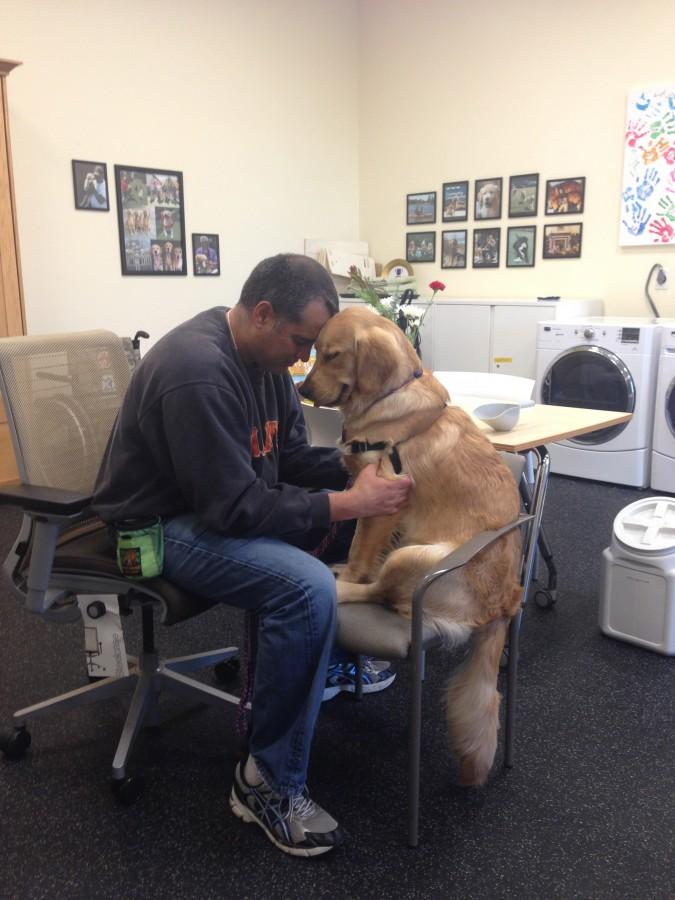PTSD vets and their life-saving pets
Photo Courtesy of Warrior Canine Connection
Sandy helping a Veteran ease his pain left over by battle at the Department of Veterans Affairs Medical Center in Menlo Park, CA on Dec. 19, 2013.
November 18, 2014
With Veteran’s day just passing us on Tues. Nov. 11th, many people may only see this day as a day off school or work, but for the veterans who have served our country, this may bring painful memories of their time in battle.
A condition called Post Traumatic Stress Disorder affects a growing number of veterans returning from war.
Granted, PTSD can occur from any traumatic event from fighting over seas to driving to work; for our veterans, this disorder can mean life or death, and in many cases, soldiers are too afraid to seek help.
More often than not, soldiers who serve and protect our country come home to a life they don’t know how to live anymore. Restless nights reliving the nightmares of war, daily tasks like waiting in line at the grocery store, going to a concert or simply driving their car can trigger an anxiety attack. Our hero’s are the ones in need of saving.
And that’s where foundations like TADSAW (Train a Dog Save a Warrior), Warrior Canine Connection, Paws For Veterans, and many others come in to lend a furry paw.
“Every single day, 22 veterans take their own lives,” TADSAW program director Bart Sherwood said. “That’s 22 suicides a day, a suicide every 65 minutes. As shocking as that number is, the real number may actually be higher.”
With so many deaths per day, what can we do to help? Well, sometimes the best medicine is not found in a pill bottle, but in unconditional love by man’s best friend.
Richard Steinberg, a Vietnam veteran that suffers from PTSD as well as diabetes, said in an interview with National Geographic, “Animals know more about body language than we ever will I’m afraid.”
His canine companion Kira knows when he has low blood sugar before Richard can even feel it. In addition, Kira can sense when Richard is beginning to have an anxiety attack and can ease his mind before things escalade.
Richard is not the only veteran who has discovered the life saving benefits of having a canine friend. Many organization are realizing the need to help our veterans cope with PTSD, and now more and more dogs are being placed with PTSD ridden veterans.
For example, an organization called Warrior Canine Connection (WCC) is leading the way when it comes to raising, pairing and training dogs for disabled veterans. According to WCC, “They begin their journeys to become service dogs for disabled combat Veterans at the WCC Puppy Enrichment Center in rural Brookeville, Maryland. During the first few months of the puppies’ lives, a team of Warrior trainers and civilian volunteers spend many hours socializing them, which is a critical step in their training.”
Recently, WCC added a West Coast location in Menlo Park, California helping the veterans find themselves again.
Research continues to confirm the therapeutic potential of Canine Connection Therapy. WCC Research Director Meg Daley Olmert is also the author of “Made for Each Other: The Biology of the Human-Animal Bond.”
The book was a result of 15 years of research where she explains,”Friendly interaction with dogs can release a powerful brain chemistry that inspires our profound sense of attachment to them. This chemical reaction can also reduce fear and anxiety, and increase a sense of trust in each other.”
Another organization called Paws for Veterans actually takes dogs who would otherwise be euthanized and pairs them with a veteran in need.
Veterans are benefitting and so are the dogs. Through training together, both dog and owner learn to trust one another and this helps our veterans overcome their PTSD.
Nathan Nail, Paws for Veterans Trainer and retired Marine can attest to the benefits of having a canine companion after nearly committing suicide, when his dog Rocky took action and snapped Nail back to reality. Nail in an interview with Paws for Veterans about PTSD and his experience went on to say, “I wouldn’t be here had it not been for my service dog.”
With so many deaths already happening overseas, we are losing an increasing number of warriors at home as well.
Despite this, organizations are taking action and recognizing the amazing power that love and acceptance can bring to a hero in need of help. All thanks to mans best friend.







































































